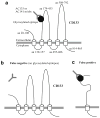The utility and limitations of glycosylated human CD133 epitopes in defining cancer stem cells
- PMID: 18535813
- PMCID: PMC2585385
- DOI: 10.1007/s00109-008-0357-8
The utility and limitations of glycosylated human CD133 epitopes in defining cancer stem cells
Abstract
Human CD133 (human prominin-1), a five transmembrane domain glycoprotein, was originally identified as a cell surface antigen present on CD34+ hematopoietic stem cells. Although the biological function of CD133 is not well understood, antibodies to CD133 epitopes have been widely used to purify hematopoietic stem and progenitor cells. The cancer stem cell (CSC) hypothesis postulates that a rare population of tumor cells possessing increased capacities for self-renewal and tumor initiation is responsible for maintaining the growth of neoplastic tissue. The expression of the CD133 epitopes, AC133 and AC141, has been shown to define a subpopulation of brain tumor cells with significantly increased capacity for tumor initiation in xenograft models. Following the discovery of the AC133/AC141+ population of brain tumor stem cells, the AC133 and AC141 epitopes have been extensively used as markers for purifying CSCs in other solid tumors. There are, however, several issues associated with the use of the AC133 and AC141 CD133 epitopes as markers for CSCs. The antibodies routinely used for purification of AC133 and AC141-positive cells target poorly characterized glycosylated epitopes of uncertain specificity. Discordant expression of the AC133 and AC141 epitopes has been observed, and the epitopes can be absent despite the presence of CD133 protein. In addition, CD133 expression has recently been shown to be modulated by oxygen levels. These factors, in combination with the uncertain biological role of CD133, suggest that the use of CD133 expression as a marker for CSCs should be critically evaluated in each new experimental system and highlight the need for additional CSC surface markers that are directly involved in maintaining CSC properties.
Figures

References
-
- Yin AH, Miraglia S, Zanjani ED, Almeida-Porada G, Ogawa M, Leary AG, Olweus J, Kearney J, Buck DW. AC133, a novel marker for human hematopoietic stem and progenitor cells. Blood. 1997;90:5002–5012. - PubMed
-
- Miraglia S, Godfrey W, Yin AH, Atkins K, Warnke R, Holden JT, Bray RA, Waller EK, Buck DW. A novel five-transmembrane hematopoietic stem cell antigen: isolation, characterization, and molecular cloning. Blood. 1997;90:5013–5021. - PubMed
-
- Peichev M, Naiyer AJ, Pereira D, Zhu Z, Lane WJ, Williams M, Oz MC, Hicklin DJ, Witte L, Moore MA, Rafii S. Expression of VEGFR-2 and AC133 by circulating human CD34(+) cells identifies a population of functional endothelial precursors. Blood. 2000;95:952–958. - PubMed
-
- Corbeil D, Roper K, Hellwig A, Tavian M, Miraglia S, Watt SM, Simmons PJ, Peault B, Buck DW, Huttner WB. The human AC133 hematopoietic stem cell antigen is also expressed in epithelial cells and targeted to plasma membrane protrusions. J Biol Chem. 2000;275:5512–5520. - PubMed
Publication types
MeSH terms
Substances
Grants and funding
LinkOut - more resources
Full Text Sources
Other Literature Sources
Research Materials

